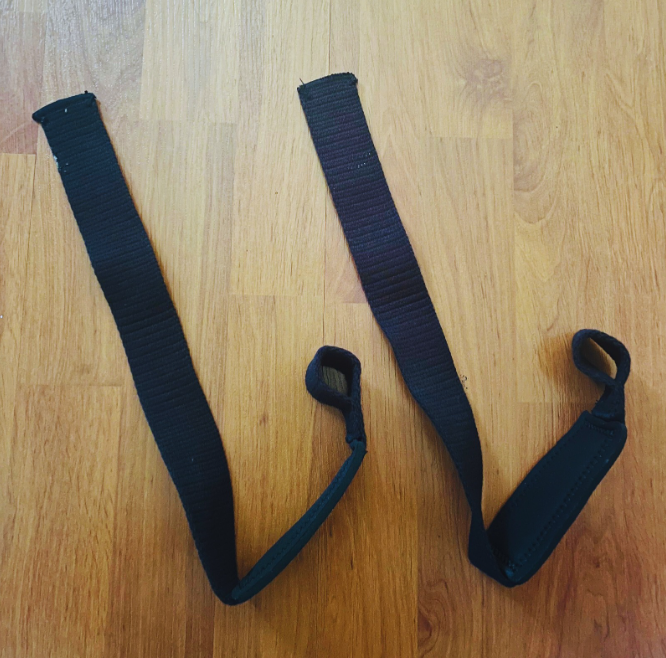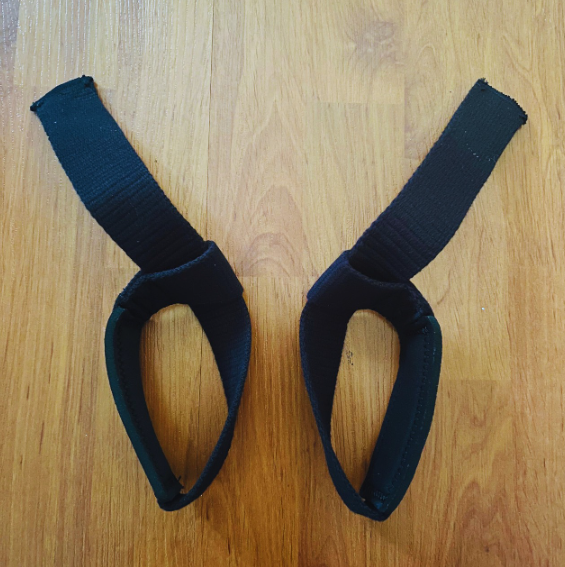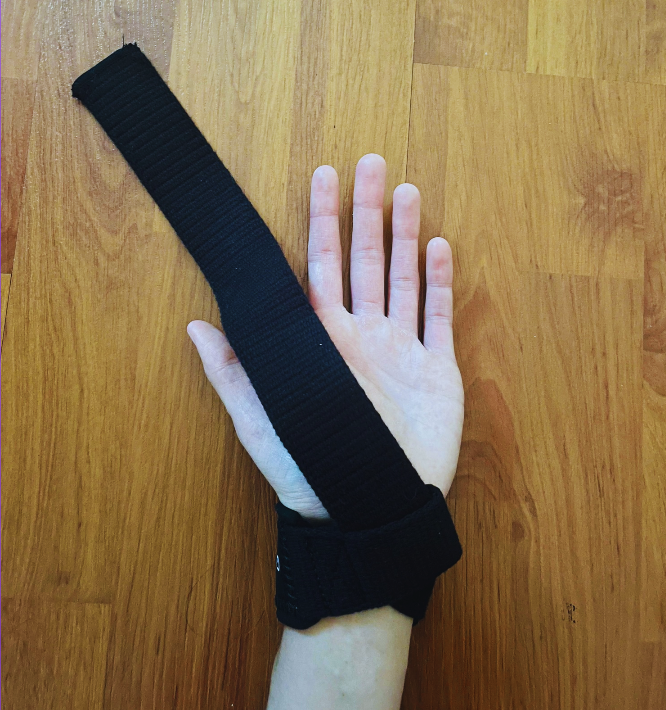Most of us weightlifters are all too familiar with the feeling of our arms getting progressively more tired and giving out mid-set.
Long before we intended to stop and far too soon for a set to be effective, all because our arms can no longer support the weight we’re lifting.
Well, this is where lifting straps come in. They’re main purpose is to prevent this from ever happening again.
If you spend frequent time in the weight room, chances are you’ve heard of or seen people using lifting straps.
Or maybe, this is your first time hearing about them altogether.
In this post, I want to cover everything there is to know about the advantages and benefits of lifting straps. As well as the exact steps you can take to start effectively using lifting straps in your next workout.
What Are Lifting Straps?
Throughout this post, you might see me refer to lifting straps as both wrist straps or lifting straps interchangeably.
But don’t worry, they’re both the same thing!
Lifting straps, or wrist straps, are fabric straps that wrap around your wrist and the weight while weightlifting.
As with most gym equipment and accessories, lifting straps are used to enhance both your experience and performance in the gym.
Providing you with additional grip, support, and comfort, lifting straps can be super beneficial for anyone who struggles in any of these areas.
How to Use Lifting Straps For Maximum Results
Now I’ll be honest, figuring out how to use lifting straps can be tricky.
Especially as someone who’s never used them before.
Although it’s tricky, it’s not impossible and once you get it down then you’ll be set from there.
The first time I tried using lifting straps, I wasn’t sure what went where, which way things went, and how they even worked.
But eventually, I did figure all this out and after just a few times using them I got it down pat.
To help save you from some of the struggle of figuring all this out, I want to provide you with detailed steps on how to use lifting straps.
A Step-By-Step Guide to Correctly Using Lifting Straps:
1. Distinguish between the two ends of your straps. One end should have a loop and the other end should be straight. I’ll refer to each of these as the looped end and the straight end.

2. For each one of your straps, loop the straight end of each strap through the hole on the looped, opposite end. This should create one large loop in the middle.

3. Loop your hand through the big loop of each of the straps, with the straight end pointing upwards until one strap is around each wrist.

4. Adjust each of the straps so the intersection between both ends of each individual strap is on the same side as your palm. Face your palms upward.
The straight end of the strap should be in line with your thumb at this point.
Like this:

If the strap is not aligned with your thumb, then your straps are on the wrong hands. Now would be the best time to switch them and repeat the first four steps.
One of the hardest parts of using lifting straps is knowing which strap goes on which hand.
That’s why I love this trick so much. It’s simple, and it works every time.
6. Place the palm of your hand as close as possible to the weight you’re going to lift, with your palm facing the weight like you’re going to grab it.
7. Place the straight end of the strap on the side of the weight opposite your fingers. Wrap this end of the strap around the weight, wrapping in the direction towards your fingers and palm.
8. Grab the weight and tighten this wrap as best you can. You’re now ready to lift.
The Best Exercises to Use Lifting Straps
The main purpose of lifting straps is to make lifting heavier, easier.
As a result, the best time to use lifting straps is when you’re either pulling or lifting heavy weight.
However, lifting straps won’t be effective for all exercises. Instead, lifting straps are only effective during certain lifts.
The main exercises where lifting straps will be most effective are ones that require grip strength.
If you aren’t familiar with grip strength, think of any exercises in the gym where you’d be struggling to pull or hold on to the weight.
For example, things like deadlifts, RDL’s, bent over rows, lat pulldowns, and so on.
All of these exercises require some pretty significant grip strength in order to do the exercises best.
As a result, these are all great exercises where using wrist straps would be appropriate and effective.
Whereas exercises like bicep curls, shoulder presses, and squats don’t require any grip strength.
And therefore wouldn’t be good exercises to use wrist straps.
The Benefits of Using Lifting Straps While Strength Training
Lifting Straps Increase Grip Strength
In my post on 6 Benefits of Daily Dead Hangs, I talked more about the importance of grip strength while weightlifting.
Primarily, the role that grip strength plays in your gym progress.
Grip strength comes down to how strong your hands, fingers, and forearms are.
It’s how much weight you can hold and for how long, using these muscles.
If you have stronger muscles here, then you’ll have better grip strength. Whereas if these muscles are weaker, then you’ll have less grip strength.
A lot of times, our grip strength holds us back from lifting as heavy as we can in the gym.
That’s why lifting gloves can be so beneficial.
You don’t want to be lifting lighter because your arms can’t keep up with the body part you’re training.
For example, if I were doing RDL’s, I wouldn’t want my lack of strength in my arms to be holding me back from effectively doing a leg exercise.
Or similarly, if I were doing lat pulldowns, I wouldn’t want my lack of grip strength to keep me from effectively training my back during a back exercise.
Like I had mentioned earlier, we’re all too familiar of having ended a set because our arms couldn’t keep up with the weight we were lifting. But this does us no good when it comes to making progress!
Lifting Straps Help You Lift Heavier (And Make More Progress)
I mentioned earlier that grip strength is how strong your arms and hands are. It determines how much weight you can or can’t lift.
Just like any other exercise in the gym, the stronger your muscles are, the more weight you can lift.
The stronger your grip strength is, the heavier you can lift! This is huge when it comes to hypertrophy training and making progress in the gym.
In order to make progress, lifting heavy is crucial!
Heavy lifting is the best way to challenge your muscles and stimulate muscle growth.
Now I mentioned the example earlier of grip strength and RDL’s.
Mainly how I wouldn’t want my lack of grip strength to be holding me back from lifting heavy enough to effectively challenge the muscle grip I’m training.
Imagine now that I was using lifting straps during my RDL’s.
Doing this, I’d eliminate the limiting factor of my grip strength, and be able to lift way heavier than I ever could on my own.
Lifting a weight that’s heavy enough to effectively train and challenge the muscles I’m training. In this case, my leg muscles and not my arm muscles.
No longer having to rely on the endurance of arms, I can take the exercise closer to failure. Without my arms getting tired and giving out beforehand.
Before I started using lifting straps, I never liked any type of exercise where my arms would give out before my targeted muscle did.
When this happened, the exercises never felt effective enough. Probably because they weren’t!
Using lifting straps helps you slow down your reps, increase your time under tension, lift heavy, and train intensely.
All of which is huge when it comes to making your workouts more effective and stimulating muscle growth.
Lifting Straps Provide Wrist Support
If you’re someone who struggles with wrist pains when working out, lifting straps might be a good option for you.
In a way, lifting straps act somewhat like a small wrist brace, wrapping tightly around this area and providing extra support.
They can help stabilize and protect your wrist, keeping this area strong and helping additional aches or injuries.
On top of that, they effectively take a lot of the tension and pressure of lifting off of your arms and hands, placing it onto themselves instead.
Lifting Straps Help Prevent Callouses
For anyone who lifts heavy, callouses are almost unavoidable.
The more often and heavier you lift, the more and bigger callouses you’ll develop on your hands.
For some people, callouses are like battle scars. They signify all the hard work, time, and effort they’ve put into themselves and their routine.
However for others, callouses aren’t so desirable.
If you’re someone who’s worried about developing callouses or wants to minimize their appearance, then lifting straps are something you might want to consider.
Don’t Let Callouses Hold You Back From Lifting Heavy
Whether it be the pain or just the thought of having calloused hands, it’s important to avoid letting this come between you and the weight room.
Otherwise, you’ll never see any of the benefits of weightlifting!
Callouses mainly form on the parts of your hands that are used for gripping. The inside of your palms, fingers, and knuckles.
They come from repetitively gripping, grabbing, or holding onto something heavy. Also known as, lifting weights!
Although the gripping and grabbing is unavoidable while lifting weights, there is one way to reduce the amount of tension and friction that’s on your hands at this point.
And that, is by using lifting straps.
By taking some of the tension off of your hands, lifting straps are an incredibly effective way to reduce and prevent callouses from developing and worsening while working out.
Lifting Straps Make Lifting Weights More Comfortable
If you’re someone who has developed callouses from lifting weights, then you probably know that they can be unpleasant for reasons besides their aesthetic appearance.
In fact, callouses can even be pretty painful at times. Especially when you re-engage in the activity that gave you those callouses in the first place.
Lifting with calloused hands can be painful. You continue to pull and tug on your dead, calloused skin which also happens to pull and tug on your live, sensitive skin that’s not calloused.
Causing you tons of irritation and pain, and occasionally leading to torn skin. Ouch.
It’s at times like these when lifting straps come in extremely handy.
I had mentioned earlier that lifting straps are designed to take some tension off of your hands while you lift.
Helping to prevent callouses, protect your already calloused hands, and protect any sensitive surrounding skin.
All of this reduces any pain or discomfort that comes from lifting and callouses.
Making your whole lifting experience a lot more enjoyable and comfortable for yourself.
Takeaways
Lifting straps are an excellent gym accessory to improve both your performance and experience in the gym.
Although learning how to use them initially can be slightly challenging, it’s nowhere near impossible.
Once you get this down, you’re grip strength will no longer be a limiting factor in any of your lifts.
You’ll be able to lift heavier weight, do more reps at this weight, and do it all more comfortably!
So if you’re hesitant about using lifting straps, consider all the ways that they can improve your workouts and your results.
More of My Posts on Women’s Weightlifting and Fitness:
How to Do Glute Step-Ups in The Gym
What to Do After Missing a Week of Workouts [A Complete Guide]